very informative about some fishes. very good.
14 Scary-Looking Sea Creatures That Could Be Your Friends
Hey! Let’s take a deep dive into ocean waters to see which of these creepy-looking animals are our friends.
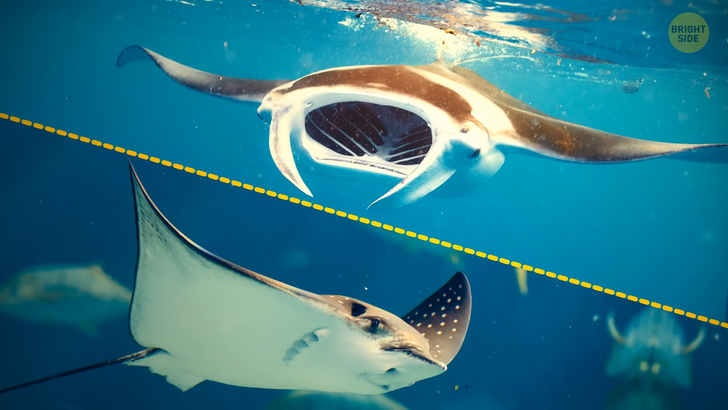
We’re swimming in the tropical waters of Nanuya Balava Island near Fiji. Can you see those giant creatures the size of a Volkswagen Beetle? Those are Manta Rays. They’ve got a long whip-like tail and large, flat diamond bodies. There are two species of Manta Rays — the Reef Manta Ray and the Giant Manta Ray. They belong to the same family as sharks, but they only have small teeth in their lower jaw. They feed on zooplankton, tiny fish, and crustaceans.
Manta Rays are social animals, and they like people. Once you let them come close to you, they’ll swim around you to observe you. Don’t chase them, though, because they’re superfast swimmers. Their name translates to “cloak” or “blanket,” and out of all sea creatures, they’ve got the largest brain compared to body-weight ratio. These fellas can recognize themselves in a mirror.
The Asian sheepshead wrasse follows. Even if it seems unsightly, it’s one of the friendliest fish you’ll come across in the shallow waters of Japan, China, and Korea. It has protrusions on both his jaw and head. It likes to hide in its anemone, and it’s usually scared to go out, even at 40 in (100 cm) long.
One of these fellas developed a friendship with a Japanese scuba diver 30 years ago. When the diver found the fish, it was injured, and he helped it recover. The diver had been the caretaker of an underwater Shinto Shrine. He calls the fish by hitting the underwater bell.
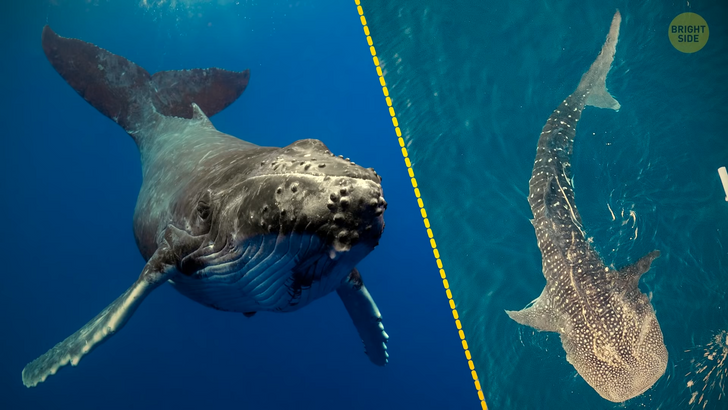
Time to go swimming with the largest fish in the world — the whale shark. Though these creatures are sharks, they have a lot in common with whales. They can live for 100 years, though they’ve got tiny brains. They’re indifferent to humans. These fellas don’t care about anything they can’t eat.
And, unlike other shark species, they won’t bite you. Whale sharks are filter feeders. They do have teeth — 3,000 of them! — but they don’t use them. They’ve got a massive mouth, like me, but their throat is only the size of a quarter.
Next, we have the sunfish. A fish without a tail that looks like it’s been cut in half. It has large fins, and when you see it breaching on the surface, you’ll think a shark is approaching. The sunfish dives deep in the water to let other fish exfoliate its skin and remove parasites.
Once they’re done, it returns to the surface to sunbathe. It’s also a voracious eater. If it sees you in the waters, it’ll likely approach you and observe you. Within a day, you’ll be able to feed it from the palm of your hand.
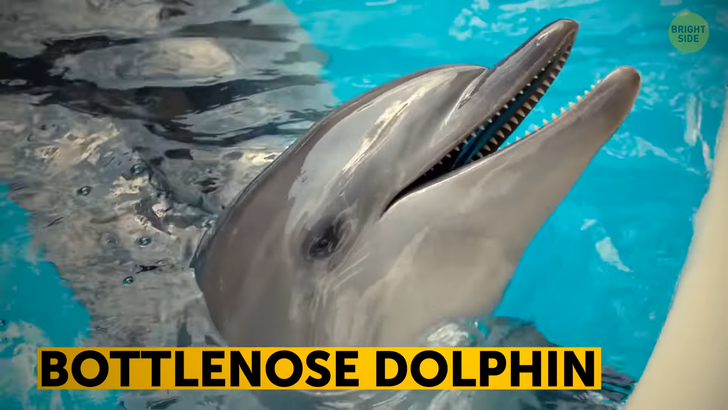
Time for the animal that looks like it’s always smiling — the bottlenose dolphin. It’s one of the most social sea creatures, and it travels in groups. It enjoys playing, hunting, raising calves, and helping out its community. Bottlenose dolphins are excellent swimmers with speeds reaching 19 mph (30 kph).
They usually come up to the surface to breathe air through the blowhole on their head. These creatures are great communicators, and they send messages to each other. They use echolocation to navigate and find food. When they spot people, they become very friendly — so much that they let their guard down, and it makes them vulnerable to other sea creatures such as sharks.
Heading to the Pacific Coast, we’ll come across some Gray Whales. Their skin is covered with parasites and other organisms that make their snouts look like rough pieces of rock. We gotta get on their nice side first. Gray Whales can attack a large boat, a ship, or a vessel if they sense their calves are in danger.
But, generally, they’re friendly and appear unbothered by rowing kayakers. In some cases, they approach small boats and allow humans to touch them, though you’re required by law to keep your distance. If it wants to get closer, it will. If it feels threatened, it will act aggressively.
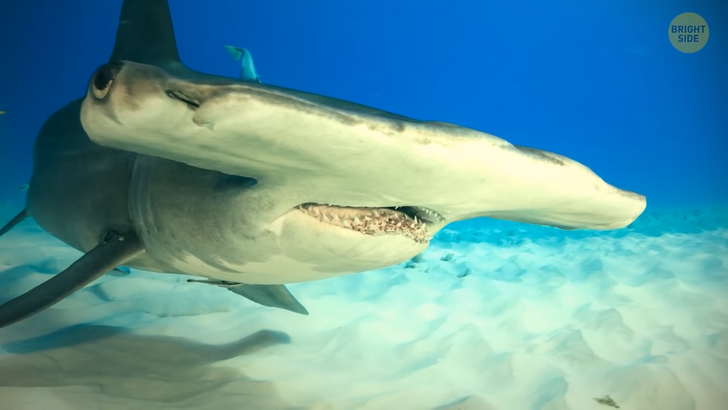
Now, let me show you a fish with a tool on its head — the hammerhead shark. Their skull helps them with hunting. Their eyes are placed on the “hammer’s” outer edges and gives them a 360-degree vertical view. But they’ve got a blind spot in front of their nose. Their heads are like metal detectors — most of what they want is below the sand’s surface.
So, they lightly dip their heads in the sand and sweep-up whatever is under there. You’ll see them in temperate and tropical waters both near the shorelines and offshore. They usually move in groups. They’re mostly harmless to humans and divers, but there have been a few occasions where they got aggressive. But before they do, they’ll give you a bunch of warning signs, and divers know how to handle them.
Now I’ll show you something kinda smaller — the Sea Lion. These creatures are a bit tricky. They’re playful, aggressive, arrogant, smart, and above all, curious. Sea lions can’t breathe underwater, but they can dive almost 1,000 ft (300 m) deep, and they can hold their breath for a long time.
They take in air through their nose, and once they dip their heads in the waters, their nostrils slam shut. If they spot humans at the beach, they’ll stay away and wait for them to leave. Wild sea lions aren’t the friendliest to anyone, especially if they feel threatened. The approachable ones have been trained in captivity.
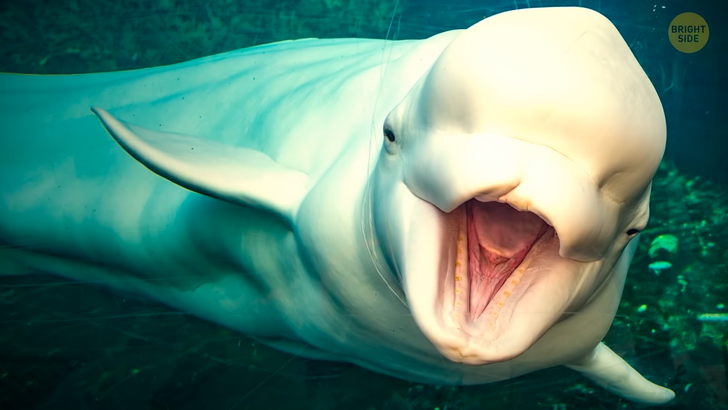
Beluga whales are next. They’re white with bulgy heads, and they’re amongst the most social and loudest you’ll ever meet. Their upwards-facing mouths make them look like they’re smiling. When Beluga whales are born, they’re a dark gray shade. It takes 8 years for their skin to turn white.
They can change the shape of their heads by blowing air around their sinuses. Beluga whales love humans. Once they make human friends, they don’t want to leave. Even though they’re wild animals, they become too entrusting with people. Marine biologists suggest staying away for their safety.
Have you heard of sea cows? Those are actually called manatees. You’ll see some in rivers and others in the oceans. Even though they’re large, they usually stay in shallow coastal areas — munching on seagrass, leaves, and algae.
Manatees bring their heads to the surface every 4 minutes or so to breathe, but they can hold their breath longer than that. They’re slow travelers, and even if they aren’t as smart as dolphins, they can understand colors. These fellas are gentle giants, and they like to approach humans searching for warmth.
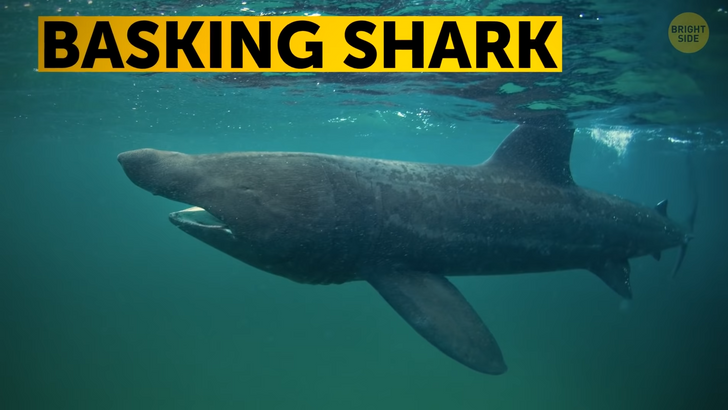
Next, we’ve got the basking shark — the second largest shark in the world. Their mouth is their most impressive feature, like me, since it can open more than 3 ft (1 m) wide, okay you win. These creatures have an intimidating appearance.
But, despite their size, they’re harmless to humans, and divers swim with them. They’re very social and can form schools of 100 individuals. They swim near the water’s surface, filter-feeding on plankton. They, too, have a bunch of teeth that they don’t use.
Do you know which creature can sing loud “songs” for 30 minutes? Actually, it’s the Humpback Whale. Scientists aren’t sure why they make those low howls and noises — they might be trying to communicate with others to attract mates. You’ll see them near coastlines feeding on tiny food, and they use their flukes to propel through the water.
Humpback whales are less friendly than gray whales because they’re very cautious. But, they’re the heroes of the ocean. They try to save other animals from Orcas, and experts say they’re capable of decision-making and problem-solving. On one occasion, a humpback whale jumped in to save a whale biologist from a tiger shark.
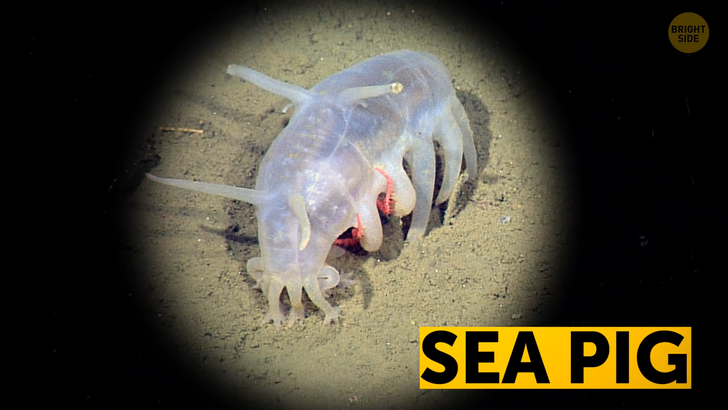
Now, let’s try to spot the expert in disguise: The Caribbean Reef Octopus. The specialized color cells help it blend in with the sand and ocean rocks’ rough texture. But Caribbean Reef Octopuses are loners — and they like to get around on their own.
This creature is also teeny tiny. It can grow almost 5 in (13 cm) and with their legs getting as long as the average person’s foot. If you get too close to them, they’ll likely turn blue and warn you that they feel threatened. Even though they’re trusting, it’s better to keep your distance to keep them calm.
A weird-looking creature walks around like a living vacuum cleaner down in the oceans’ pitch-black depths. I’m talking about Sea Pigs. They got their name from their pinkish bodies, and they fit in the palm of your hand. These creatures don’t swim, they walk around on the seafloor. Their legs consist of 5 to 7 pairs of enlarged tube feet, and they have tentacles around their mouths to fiddle through the mud to find scum to munch on.
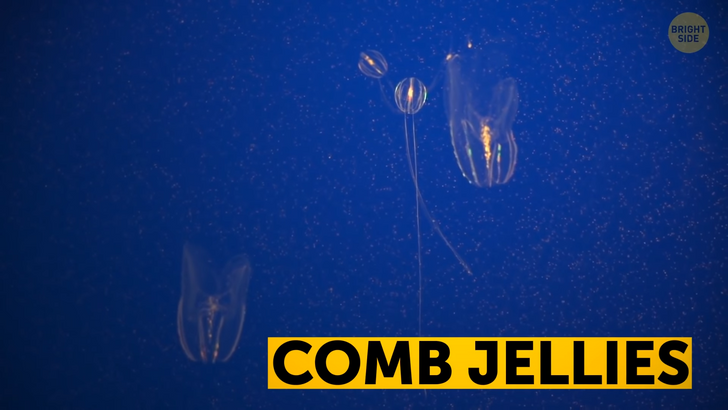
Yumbo! Since they’re vulnerable, they have poisonous skin for protection against other sea creatures. If you encounter one, it’ll be quite friendly, but if you want to keep it as a pet, you’ll need a VERY deep tank.
Speaking of slimy water creatures, let’s talk about comb jellies. They’re friendly animals that like to swim close to the shore on warm summer evenings. There are two types of comb jellies — some with two tentacles and some without any. You can spot them at night since they glow in the dark and light up the waters.
One of them is the Sea Gooseberry. On the sand, it looks like a transparent blob of Jell-O, and it can fit into a teaspoon. Unlikely jellyfish, comb jellies don’t sting because they don’t have stinging cells, and they’re safe to swim with.
Comments
Related Reads
Helen Hunt, 60, Stuns During Her Latest Appearance, and Her Lips Become the Center of Attention

Miley Cyrus Causes a Stir by “Leaving Nothing to the Imagination” as She Wears an Extremely Revealing Dress

Keanu Reeves Finally Cuts His Long Hair, and His New Look Causes a Stir

Céline Dion Shares a Rare New Photo of Herself Amid Disease Battle, and People Praise Her

A Homeless Woman Receives a Full Makeover and Impresses the Whole World

Tom Cruise Deemed Unrecognizable in New Pics With Prince William, as Some Say He Had “Too Much Surgery”

A Girl Born Without Nose, Who Was Called “Voldemort”, Proved Everyone Is Beautiful in Their Own Way

«I Thought She Couldn’t Lose Weight,» Keely Brosnan Looks Completely Transformed in New Pic

Dakota Johnson’s Naked Dress Divides the Internet, as Some Deem It Has “No Class”

Anne Hathaway Deemed Unrecognizable After Her Face Shocked Many in New Pics

Miley Cyrus Raises Eyebrows as She Wears a Naked Dress Made Only of Safety Pins at the 2024 Grammys

People Online Noticed Brad Pitt’s New Partner Is a Spitting Image of Angelina Jolie
